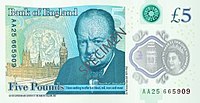Bank of England £5 note
| (United Kingdom) | |
|---|---|
| Value | £5 |
| Width | 125 mm |
| Height | 65 mm |
| Security features | See-through window, finely detailed metallic image, coloured border which changes from purple to green when the note is tilted, silver foil patch, microlettering, textured print |
| Paper type | Polymer |
| Years of printing | 1793-present |
| Obverse | |
 |
|
| Design | Queen Elizabeth II |
| Design date | 13 September 2016 |
| Reverse | |
 |
|
| Design | Winston Churchill |
| Design date | 13 September 2016 |
The Bank of England £5 note, also known as a fiver, is a banknote of the pound sterling. It is the smallest denomination of banknote issued by the Bank of England. In September 2016, a new polymer note was introduced, featuring the image of Queen Elizabeth II on the obverse and a portrait of Winston Churchill on the reverse. The old paper note, first issued in 2002 and bearing the image of prison reformer Elizabeth Fry on the reverse, is being phased out and will cease to be legal tender on 5 May 2017.
Five pound notes were introduced by the Bank of England in 1793, following the ten pound note which had been introduced in 1759 as a consequence of gold shortages caused by the Seven Years' War. The 5 pound note was introduced again, due to gold shortages caused by the French Revolutionary Wars and the Napoleonic Wars and was the lowest denomination of note issued until 1797. The earliest notes were handwritten and were issued as needed to individuals. These notes were written on one side only and bore the name of the payee, date and the signature of the issuing cashier.
In 1797 due to the extra money need to fund the war and uncertainty caused as England declared War on France, a series of bank runs drained the Bank of England of its gold supply. They were forced to stop exchanging gold for notes and to issue notes of £1 and £2 denominations. This was known as the 'restriction period', as the exchange of notes for their value in gold was restricted.
The Restriction Period finished in 1821 as the Government has to anchor the value of the currency to gold in order to control sharply rising inflation and national debt. After a brief period to offset any sudden deflation, the UK returned to the gold standard on 1 May 1821. These notes could again be exchanged in full, or in part, for an equivalent amount of gold when presented at the bank. If redeemed in part, the banknote would be signed to indicate the amount that had been redeemed. From 1853 printed notes replaced handwritten notes, with the declaration "I promise to pay the bearer on demand the sum of five pounds" replacing the name of the payee. This declaration remains on Bank of England banknotes to this day. A printed signature of one of three cashiers appeared on the printed notes, though this was replaced by the signature of the Chief Cashier from 1870 onward.
...
Wikipedia
